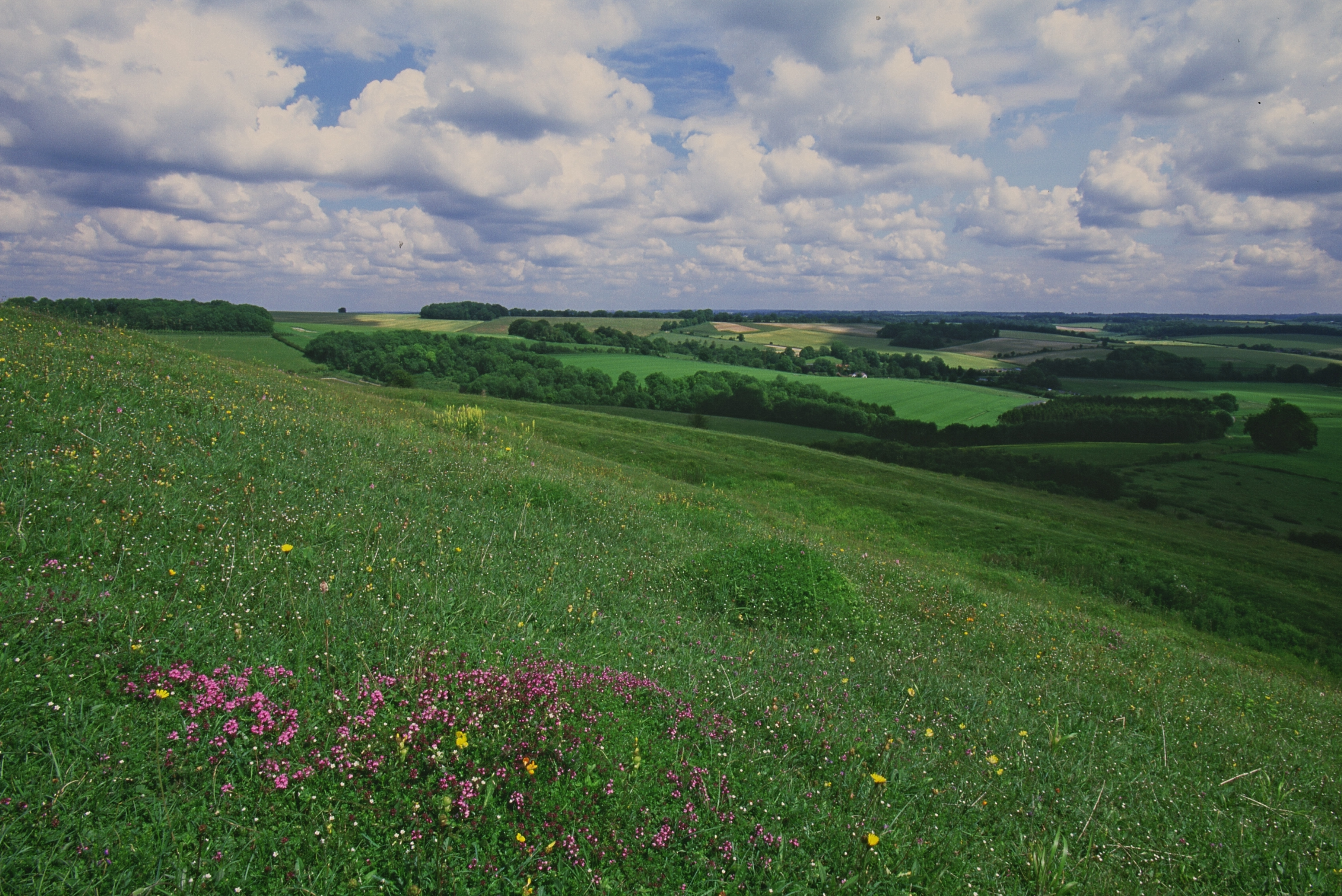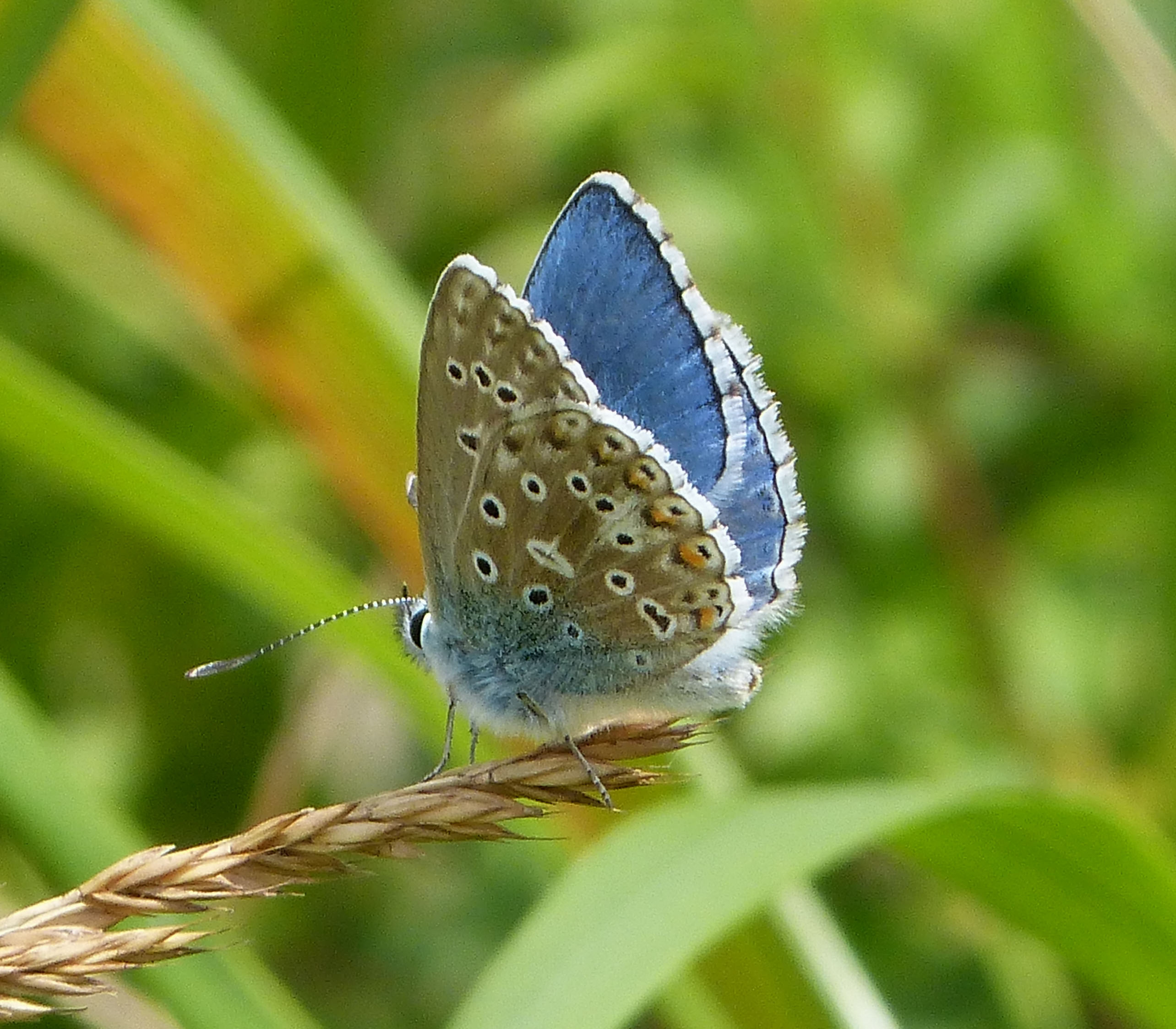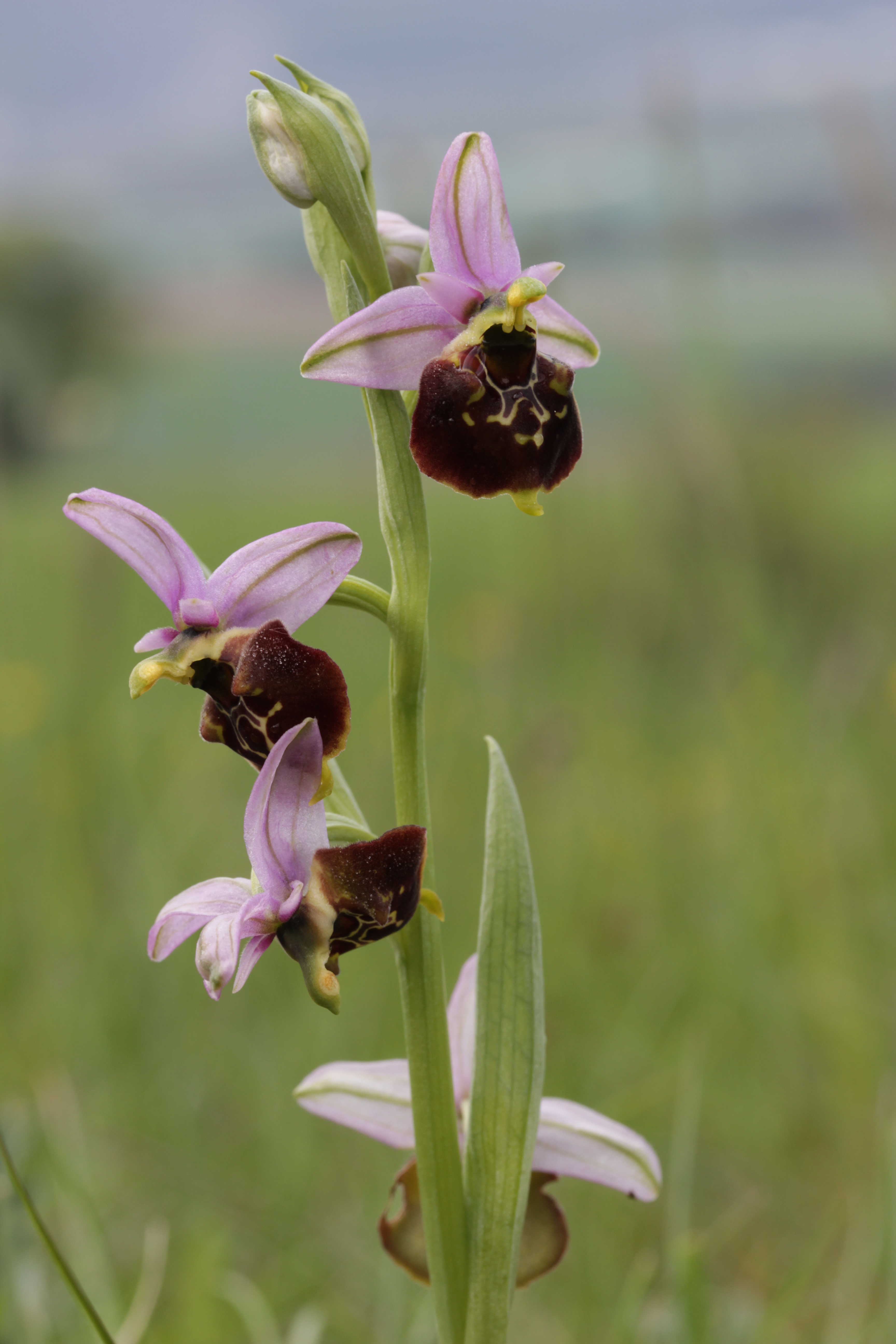About a third of Britain’s sixty resident butterfly species may be encountered on chalk grasslands.
This piece originally appeared in the Spring 2018 edition of Xerces’ biannual publication Wings. Click to view the full Spring 2018 issue.
“Lack of concentration inhibits standard and rate of work.” Schoolteachers in Britain didn’t mince their words in 1970—or at least mine didn’t! In my defense, they shouldn’t have had a geology map on the classroom wall. The bold colors and intriguing patterns were much more interesting than math and spelling to an easily distracted seven-year- old. I didn’t know much about geology back then, but I did know that the red patches were where volcanoes had erupted and that dinosaurs had been walking around when the rocks in the big blue area were forming. How could learning multiplication tables be expected to compete with that?
One of the more obvious features of a geology map of Britain is the broad bands of color that sweep across the southeastern portion of the country, in contrast with the disjointed and fragmented patterns to the north and west. One of these bands, often colored green, stretches nearly half the length of the island, forking and then forking again to reach the sea in at least four places, representing the chalk that underlies some of the country’s most iconic landscapes: the mystical settings of Stonehenge and Avebury, which contain millennia of human history; the rounded hills of southern England, dotted with sheep; and the White Cliffs of Dover, which stood as a symbolic bulwark against Hitler during the Second World War.
Geologically speaking, chalk is a very soft limestone, almost pure calcium carbonate. It was created at the bottom of warm tropical seas, the accumulated remains of billions of marine plankton, “coccoliths,” that died and settled on the seabed over a period of thirty million years. After Africa bumped into Europe about sixty-five million years ago—an event that created the Alps—this layer slowly bent and rose upward, dispersing the sea and becoming the hills that form the skeleton for what is now southern Britain. A bit confusingly, these uplands are known as downs (derived from dūn, the Old English for hill).
Although the English downlands contain several characteristic habitats—the beech woods of the Chiltern Hills, for example—the grasslands are the most distinctive. From afar, downs typically look bare and rounded. The chalk is porous, so rainwater percolates quickly, leaving the hills dry. In addition, the soils are shallow and infertile, partly from that percolating water leeching out nutrients. Add a layer of human history—centuries of sheep grazing, assisted by wild rabbits established after being brought to Britain by the Romans—and the overall result is a landscape in which trees struggle and grassland dominates.

Chalk grassland is short due to the grazing. The sward is seldom more than four inches high and in places less than an inch, very different from the image of grasslands that one might have formed based upon hay meadows or tallgrass prairie. Because the grass is so short, flowers face less competition, and these grasslands support a remarkable diversity of plants, upwards of forty species in a square yard. And the wildflowers are such beauties: meadow clary, bell flower, cowslip, kidney vetch, devil’s-bit scabious, salad burnet, roundheaded rampion, burnet saxifrage, and several orchids, including bee, spider, man, fragrant, and pyramidal. Sitting on a sun-drenched slope surrounded by such diversity is always a treat, but the major delight of any summer’s day on the downs is the butterflies.
About a third of Britain’s sixty resident butterfly species may be encountered on chalk grasslands, including small skipper, green hairstreak, small copper, meadow brown, Duke of Burgundy, and marbled white, but it is a handful of blues—common, chalkhill, small, and Adonis—that may be most characteristic of this habitat, the latter two in particular, as in Britain they are found only on chalk or limestone grasslands. In a good year on a good site there may be thousands of them in a blue haze above the sward.

For a landscape whose character was so determined by human activity, it should be no surprise that the loss of chalk grasslands has also been caused by human enterprise. Beginning in the late 1700s, the changing economics of farming led to a transition on the downs from sheep pasture to cropland. This conversion continued into the twentieth century, accelerating after the Second World War with the advent of more-powerful machinery and the introduction of chemical fertilizers.
Cumulatively over the past two centuries more than 80 percent of chalk grassland has been lost. Where it once stretched from horizon to horizon it has been reduced to increasingly isolated patches, frequently on hillsides too steep for the plows, and neglect has thus allowed the grass to grow taller, smothering the flowers. In the county of Wiltshire, for example, which in the region around Stonehenge formerly contained some of Britain’s largest areas of downland, nearly half disappeared in the three decades prior to 1970, around the time when I was staring at that classroom map. I didn’t realize it then, but I would come to spend significant parts of my career on chalk grasslands, working on sites whose recent history illustrate the threats these habitats face.
By the mid-1980s I was studying land management as a post-graduate student, and my weekends were spent volunteering with a conservation group doing practical tasks of habitat management. Many of those duties involved clearing scrub from chalk grassland, experience that helped in one of my first jobs out of college at the National Trust’s estate on White Horse Hill in the southwest corner of Oxfordshire. This site is home to the world-famous Uffington White Horse, a three-thousand-year-old chalk figure carved into the hillside, which is topped with Iron Age fortification. By the late twentieth century, White Horse Hill had been hemmed in by arable fields, leaving less than three hundred acres of ancient grassland. Fortunately, because of the horse and the hillfort, this land had not been abandoned and the slopes were still carpeted with flowers. In recognition of its rich flora, the hill had been declared a Site of Special Scientific Interest (SSSI, a national designation). My daily responsibilities included ensuring that the sheep were grazing the proper areas of grassland to maintain the short sward without damaging it, controlling problematic weeds such as invasive thistles, and containing the spread of hawthorn scrub.
Some years later, after working in Essex and then overseas in Kenya, I returned to the English chalklands, this time in Kent, where they meet the sea. There I helped with managing surviving grasslands on the Folkestone Downs, on Dover’s Western Heights, and at the top of the White Cliffs, as well as with the creation of new grasslands along the foot of the White Cliffs, at Samphire Hoe. Unlike White Horse Hill, these places had not had a conservation-minded landowner, and the grasslands had suffered the declines that were typical for postwar Britain. Where it was flat enough, the land was now covered with crops, and any remaining grassland had been “improved” with fertilizer and herbicides. Because they were at the edges of urban areas, housing bit chunks out of their lower levels and unstructured recreation intruded everywhere, making it increasingly difficult to keep livestock.
Grazing had stopped in the years after the Second World War and scrub gradually encroached. Compounding this, the myxomatosis virus reached Britain in the 1950s, killing some 95 percent of the rabbit population over the next decade and a half, leaving nothing to keep the remaining grass short. Even so, the steeper slopes still supported significant areas of unimproved grassland and, maybe more remarkably, colonies of chalkhill and Adonis blues. As a result, the Folkestone Downs had been designated an SSSI.

Luckily for these hills, the British terminus of the Channel Tunnel was built at the foot of the Folkestone Downs. This meant that Eurotunnel became the benevolent landowner that the hills needed and, in partnership with the city councils of Folkestone and Dover, it launched the White Cliffs Countryside Project, with the intention of conserving the disappearing grasslands. By the mid-1990s, weekly volunteer efforts were dedicated to restoration, including removing the scrub. Carefully managed grazing by cattle and sheep helped provide long-term management, with project staff working in close cooperation with local farmers to ensure that grazing was done at the appropriate interval and intensity. This was often accomplished employing rare livestock such as Dexter cattle, a particularly small breed that could better thrive on the relatively poor forage and needed little more than a bush for shelter during bad weather.
This is also the place where I became a pollinator nerd. The Folkestone Downs are among the few places where one of Britain’s rarest plants, the late spider orchid (Ophrys fuciflora), grows. In 1990, when the White Cliffs Countryside Project reintroduced grazing, there were only six such plants. By the time I worked there the number had increased, thanks to habitat restoration work done up until then, but we were still spending time pollinating orchids by hand. Spider orchids have a pollination method known as “pseudocopulation.” The lower petal on each flower resembles a bee closely enough to entice a male bee to try to mate with it. During the attempt, packets of pollen, “pollinia,” get attached to the bee, which transfers them to another flower. (Apparently, one failed effort to mate isn’t enough to deter the bee from trying its luck multiple times!) At the Samphire Hoe site, I had the chance to watch bees in action on a closely related plant, the early spider orchid (O. sphecodes). I soon came to learn that both those bees (genus Andrena) and their counterparts (genus Eucera) that were no longer present to pollinate the late spider orchids on the Folkestone Downs are solitary, ground-nesting bees. For me, who at the time thought bees lived only in hives, this was a revelation, and one that led indirectly to a career shift and a focus on pollinator conservation.

Chalk downland is just one example of declining grassland habitat. Wherever they occur, whatever they are called—meadows, prairies, savannas, heaths—grasslands are among the most threatened habitats, prone to plowing, “improvement,” development, and loss of diversity through simple neglect. Maintaining them often relies on stopping the encroachment of scrub or woods, preventing the grass from becoming overgrown, and keeping nutrient levels low, but the reward is some of the most strikingly beautiful landscapes, awash with color from flowers and insects.
And my school reports? Despite my poor showing in math, I rated much better in geography (“an intelligent interest taken”) and nature study or science (“good”), so, in the end, I guess that green band on the geology map did lead me in the right direction.
Further Reading
Read the full Spring 2018 edition of Wings Magazine.
View all of our online editions of Wings.




